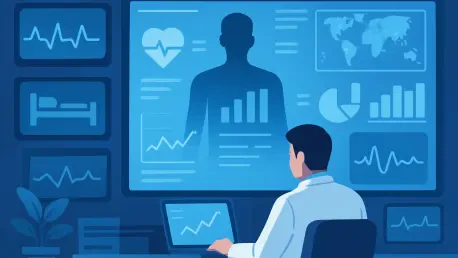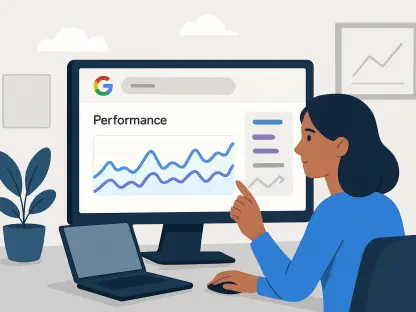In a nation as vast and diverse as India, where healthcare challenges range from overcrowded urban hospitals to underserved rural clinics, the integration of real-time analytics and business intelligence (BI) tools is sparking a quiet revolution, shifting the paradigm from sluggish, reactive decision-making to dynamic, proactive strategies that save lives and enhance efficiency. Across the country, hospitals and public health systems are tapping into live data streams to make split-second decisions, fundamentally reshaping how care is delivered. This isn’t merely about adopting the latest gadgets; it’s about tackling deep-rooted issues like prolonged wait times, preventable medical errors, and critical resource shortages. As digital tools become the backbone of clinical and operational processes, they’re paving the way for a healthier, more responsive system that prioritizes patient outcomes and systemic resilience in equal measure.
The Power of Data-Driven Decision-Making
Real-Time Impact on Patient Care
Real-time analytics is proving to be a game-changer in enhancing patient care by enabling faster clinical responses and significantly reducing errors in treatment. Hospitals equipped with electronic health records (EHRs) and live dashboards can monitor patient conditions continuously, allowing doctors to detect anomalies instantly. For instance, when vital signs deviate from normal ranges, BI systems trigger alerts, ensuring timely interventions that can prevent complications. This immediate access to data is crucial in high-stakes environments like emergency rooms, where every second counts. Beyond individual cases, these tools also help identify broader patterns, such as potential outbreaks or medication misuse, enabling clinicians to adjust protocols on the fly. The result is a marked improvement in patient safety, addressing global concerns about preventable harm that affects millions annually.
Moreover, the precision offered by real-time analytics extends to personalizing patient treatment plans with remarkable accuracy. By analyzing live data from multiple sources, including past medical histories and current health metrics, healthcare providers can tailor interventions to individual needs rather than relying on generalized approaches. This capability is particularly vital in managing chronic conditions, where slight adjustments in medication or therapy can make a substantial difference in outcomes. Additionally, BI tools flag potential adverse events, such as drug interactions, before they occur, minimizing risks that often go unnoticed in manual systems. This shift toward data-driven precision not only boosts confidence among medical staff but also fosters trust among patients, who benefit from care that feels both responsive and customized to their unique health profiles.
Operational Efficiency Gains
The impact of BI tools on hospital operations is equally transformative, as they streamline workflows and optimize resource allocation with unprecedented efficiency. Predictive scheduling, powered by real-time data, has slashed average wait times in many facilities, particularly in government hospitals where delays once averaged over 20 minutes per patient. Administrators can now anticipate patient inflows and allocate staff and equipment dynamically, ensuring that bottlenecks are addressed before they escalate. This approach has proven invaluable during peak times, preventing the chaos of overcrowding and ensuring smoother patient experiences. The ability to make informed decisions in the moment is redefining operational standards across the sector.
Equally critical is the role of real-time analytics in crisis management, as demonstrated during the COVID-19 pandemic when live dashboards became lifelines for resource distribution. Hospitals relied on these systems to track bed availability, oxygen supplies, and critical equipment in real time, enabling rapid responses to urgent needs. This technology allowed for seamless coordination between facilities, ensuring that no patient was left without care due to logistical failures. Beyond emergencies, such tools continue to enhance day-to-day inventory management, reducing waste and ensuring that supplies like medications are always on hand when needed. The operational overhaul driven by BI systems is not just about cutting costs—it’s about building a resilient framework that can withstand unexpected challenges while maintaining high standards of service delivery.
Government-Led Digital Initiatives
Building a Connected Health Ecosystem
At the heart of India’s healthcare transformation lies the Ayushman Bharat Digital Mission (ABDM), a groundbreaking initiative that has issued nearly 79.9 crore digital health IDs to date. This program creates a unified digital framework that connects healthcare providers across urban and rural divides, ensuring that patient data is accessible wherever care is sought. Interoperability is the cornerstone of this ecosystem, allowing hospitals, clinics, and even mobile health units to share live information seamlessly. Such connectivity means that a patient’s medical history, test results, and treatment plans are no longer siloed, enabling continuity of care even in remote areas. The result is a more cohesive system where data flows freely, breaking down barriers that once hindered effective healthcare delivery.
Furthermore, ABDM’s digital infrastructure empowers smaller facilities to leverage the same advanced tools as their urban counterparts, leveling the playing field in a country with stark regional disparities. By integrating live data into everyday operations, rural clinics can now coordinate with larger hospitals for specialized care, ensuring timely referrals and follow-ups. This interconnected network also supports telemedicine, bringing expert consultations to patients who previously had little access to such services. The mission’s emphasis on inclusivity ensures that technology benefits not just the privileged few but the entire population, fostering a sense of equity in healthcare access. As this ecosystem expands, it sets a global benchmark for how national digital initiatives can drive systemic change through shared data resources.
Predictive Analytics for Public Health
Government-supported predictive analytics is reshaping public health by enabling authorities to anticipate and mitigate health crises before they spiral out of control. Using AI-driven tools, states like Kerala are forecasting disease trends, identifying potential outbreaks of conditions such as diabetes and hypertension with remarkable accuracy. These systems analyze vast datasets, including environmental factors and historical health records, to pinpoint at-risk communities and prioritize early interventions. By shifting the focus from reaction to prevention, predictive analytics ensures that screening programs and vaccination drives are deployed where they’re needed most, maximizing impact while conserving resources. This proactive stance is redefining how public health challenges are addressed on a national scale.
Additionally, the integration of predictive tools into public health strategies allows for real-time tracking of emerging threats, such as antibiotic resistance or seasonal epidemics. By correlating data from hospitals and laboratories, authorities can map resistance patterns and adjust treatment guidelines accordingly, curbing the spread of resistant strains. This approach also aids in resource planning, ensuring that medical supplies and personnel are prepositioned in vulnerable areas ahead of predicted surges. The economic benefits are significant, as early action reduces the burden of prolonged outbreaks on healthcare systems and communities alike. As these technologies evolve, they promise to fortify public health resilience, equipping India to handle future challenges with data as a powerful ally.
Challenges and Future Needs
Data Governance and Privacy Concerns
As India’s healthcare systems become increasingly digitized, the importance of robust data governance cannot be overstated, particularly when it comes to safeguarding patient privacy. With vast amounts of sensitive information flowing through interconnected networks, the risk of breaches or misuse looms large if proper safeguards aren’t in place. Policies must ensure data integrity while maintaining strict confidentiality, especially under frameworks like ABDM where interoperability is key. The National Health Authority’s push for open digital health stacks is a step in the right direction, but consistent enforcement of standards across public and private entities remains a challenge. Without airtight governance, trust in these systems could erode, stalling the progress of tech-driven healthcare initiatives.
Equally pressing is the need to address disparities in data handling practices, which can undermine the reliability of analytics tools if left unchecked. Inconsistent data entry, often a result of varying technological capabilities across facilities, can skew insights and lead to flawed decision-making. Establishing uniform protocols for data collection and storage is essential to ensure that every piece of information contributes to accurate outcomes. Additionally, educating stakeholders about privacy regulations and ethical data use is critical to prevent unintentional lapses. As digital connectivity grows, prioritizing governance will be the linchpin in maintaining a balance between innovation and security, ensuring that patient trust remains intact amidst rapid technological advancements.
Training and Private Sector Collaboration
The successful adoption of real-time analytics hinges on comprehensive staff training to bridge the gap between technology and its practical application in healthcare settings. Many medical professionals and administrators, particularly in under-resourced areas, face steep learning curves when introduced to BI tools and digital systems. Without proper guidance, the risk of errors or underutilization increases, diminishing the potential benefits of these innovations. Structured training programs, tailored to different skill levels, are essential to equip staff with the confidence and competence needed to navigate complex dashboards and interpret live data. Such initiatives must be ongoing to keep pace with evolving technologies, ensuring that human capability matches the sophistication of the tools at hand.
Private sector collaboration also plays a pivotal role in scaling these technologies to meet India’s diverse healthcare demands, offering solutions that complement government efforts. Companies are stepping up by developing secure, modular BI platforms that align with national standards, making integration smoother for hospitals of all sizes. These partnerships bring not only technical expertise but also investment in innovation, driving the creation of tools that address local challenges like legacy system compatibility. By fostering trust through transparent practices and scalable designs, the private sector helps build a sustainable tech ecosystem. Looking ahead, stronger alliances between public and private entities will be crucial to refine these systems, ensuring they evolve in step with the nation’s needs while maintaining accessibility and reliability.
Shaping a Tech-Driven Healthcare Future
Reflecting on the journey so far, the integration of real-time analytics and BI tools has already begun to redefine India’s healthcare landscape by tackling inefficiencies and elevating patient care standards. The strides made through government initiatives like ABDM and the ingenuity of private sector solutions have laid a solid foundation for a data-centric approach. Hospitals have adapted to live data for clinical precision, while public health measures have grown more proactive with predictive insights. Yet, as challenges around data governance and training persist, the path forward demands focused action. Strengthening digital infrastructure, enforcing privacy standards, and expanding training programs emerge as vital next steps. Encouraging deeper public-private collaboration could further accelerate innovation, ensuring that technology continues to serve as a bridge to equitable, efficient healthcare for every corner of the nation.









